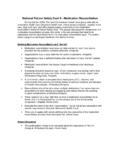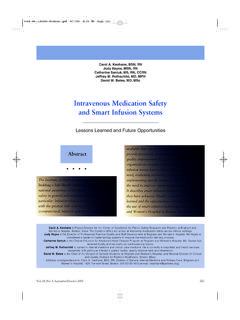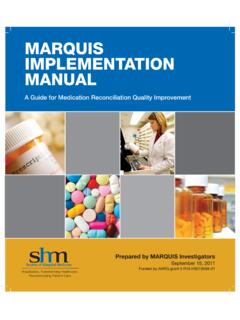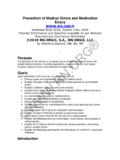Transcription of The New Patient Safety Officer: A Lifeline for …
1 SOLUTIONS FOR LEADERS. The New Patient Safety officer : A Lifeline for patients , A Life Jacket for CEOs Charles R. Denham, MD. Abstract: Virtually every health care organization in the United States faces the daunting task of transformation. The high seas of transparency and hazards of evolving systems failures lurking under the waterline pose serious risk to survival of hospitals and the careers of their leaders. New performance measures, standards, and practices will drive entirely new behaviors by hospitals, requiring important cultural and operational changes, or they will have an impact on payment and reputation through the actions of purchasing, quality, and certifying organizations. The personal success of CEOs and trustees, and the sustainability of health care organizations, will become tightly coupled to the success of Safety leaders and Patient Safety officers. As such, it is vital that a careful and systematic approach be undertaken to both the design of this new role and the selection of such leaders.
2 Their knowledge, skills, talents, and, most importantly, their values must be measured against a new and evolving set of Safety challenges facing health care institutions. They will be a Lifeline to patients and a life jacket for CEOs. Key Words: Patient Safety officer , PSO, Patient Safety leader, safe practices NEW DEMANDSVA NEW ROLE. Whether their job title is BPatient Safety officer (PSO)[ or not, the new breed of Patient Safety leader must be an educator, a diplomat, an analyst, a student, a negotiator, a communicator, and a person who understands broad strategies and granular tactics. To be an agent of change, they must not only have a high intelligence quotient (IQ) but also, perhaps more importantly, a high emotional quotient (EQ)Vthat is to say that they must have solid people ,2. Most of all, they must be leaders who earn the respect of those who can influence the behaviors of everyone up and down their organizations because their impact will be made through The banner of an organization's history is like a moving map, invisibly woven on a real time basis through the collective behavior of its people.]
3 To make Safety an intrinsic property of a culture, the threads of respect, ethics, Patient centeredness, and reliability, science must be fed by our Safety leaders into the loom of the C-suite and governance. For in the end, all the Safety science in the world will not create change. Only those who are at the helm can change the course. Governance and CEOs control the resources and the focus of the organization. They need strong and consistent support from their Patient Safety leaders to transform the fabric of their organizations. There are new drivers that demand that we rethink the roles of PSOs and the attributes we should seek in them. The harmonized National Quality Forum (NQF)Yendorsed Safe Practices for Better Healthcare,4 new and evolving Safety Goals of the Joint Commission for Accreditation of Healthcare Organizations (JCAHO),5,6 the recently announced 5 Million Lives Campaign led by the Institute for Healthcare Improvement (IHI) that builds on the 100,000 Lives Campaign launched in 2004,7 the 2007 Leapfrog Survey released in the first quarter of 2007,8 and the ever-increasing demand for transparency are but just a few.
4 From the Publications Dept., Texas Medical Institute of Technology, Austin, Texas. Supported by Texas Medical Institute of Technology. Correspondence: Charles R. Denham, MD, Publications Dept., Texas Medical Institute of Technology, 3011 N Inter-regional Highway-35, Austin, TX 78722. (e-mail: Copyright * 2007 by Lippincott Williams & Wilkins J Patient Saf & Volume 3, Number 1, March 2007 43. Copyr ight Lippincott Williams & Wilkins. Unauthorized reproduction of this article is prohibited. Denham J Patient Saf & Volume 3, Number 1, March 2007. HARMONIZED NQF-ENDORSEDTM ongoing basis. More than 97% identified performance gaps SAFE PRACTICES that they have targeted for improvement that became obvious In January of 2006, a set of 30 safe practices was through the process; 100% of those took actions to improve in published that were fully harmonized across JCAHO, the a formal process. The clear message was that transparency drives leader Centers for Medicare and Medicaid Services (CMS), the engagement; leader engagement drives budgets, and budgets Leapfrog Group, the Agency for Healthcare Research and drive Safety .)
5 As we craft the roles for Patient Safety leaders Quality, and the IHI 100,000 Lives Campaign. This provided and officers, it will be important that they are supported by a common road map for health care organizations and a governance and administrative leaders, have resources, and substantive input source for the action plan blueprints for have a systematic approach to Patient Safety leaders and This effort had been preceded by the NQF report BSafe Practices for Better JCAHO Patient Safety GOALS. Healthcare,^ released in 2003, composed of 30 safe practices In addition to the contribution that JCAHO made to the intended to have specificity, benefit, evidence for effective- harmonized NQF Endorsed Safe Practices, it continues to ness, generalizability, and In short, the objective focus on the reduction of preventable harm. was to provide practices that would have life-saving impact As of the time of this writing, the JCAHO proposed across many care settings.
6 The Leapfrog Group had already changes or additions for 2008 to existing National Patient been surveying hospitals regarding the adoption of three of Safety Goals (NPSGs) that include the following: the practices, including computerized physician order entry, & Organization investigation and planning for use of evidence-based referral, and intensive care unit coverage. technology to assist with Patient identification as part of After the publication of the NQF 2003 report,10 the existing NPSG goal 1. Texas Medical Institute of Technology (TMIT) committed to & New requirements within the existing NPSG goal 3 for the fund research and development in the domains of the selection, procurement, storage, ordering, dispensing, safe practices. TMIT then developed, for the Leapfrog administration, and monitoring processes related to anti- Group, a survey, weighing system, and scoring approach coagulation therapy. with a world class team of Safety experts that allowed & New proposed goal 16 to improve recognition and response hospitals to report on adoption of the balance of the 27 to changes in a Patient 's condition.
7 Practices. The program has been updated each year. In 2005, a & New proposed goal 17 to reduce the risk of postoperative total of 1267 hospitals responded to the survey from multiple complications for patients with obstructive sleep apnea. rollout regions. & New proposed goal 18 to prevent Patient harm associated The learning from the Leapfrog effort and soon-to-be with health-care worker fatigue. published detailed findings of the TMIT safe practice & New proposed goal 19 to prevent catheter and tubing research were inputs to the development of an entirely updated set of the original NQF practices in 2006. Three practices were incorporated into existing ones, and 3 new safe The nature of these new proposed standards further practices were developed, which included disclosure, direct expands the role of PSOs and Safety and quality leaders. They caregiver workforce, and medication reconciliation. require even more interaction between executive adminis- A major focus of the committee was to develop and trative teams, including those in charge of operations and refine a practice entitled BCreating and Sustaining a Culture multiple of Patient Safety .
8 ^ This practice is core to the new responsibilities of the Patient Safety leaders and recognizes IHI'S 5 MILLION LIVES CAMPAIGN. the continued need for emphasis on leadership. It is composed The IHI President and CEO, Donald Berwick, MD, of 4 elements: MPP, speaking before thousands of health care professionals, & leadership structures and systems; recently announced a national campaign to dramatically & culture measurement, feedback, and interventions; reduce incidents of medical harm in hospitals (Satellite & teamwork and team-based interventions; and Communication, December 9, 2006). The B5 Million Lives & identification and mitigation of risks and hazards. Campaign^ challenges hospitals to rapidly improve the care they provide to protect patients from 5 million incidents of The research included an analysis of a number of medical harm over a 24-month period, ending December 9, research topics from surveys, focus groups, input from 2008. This represents a continuation of the largest improve- multiple national task forces of subject matter experts, and ment effort undertaken in recent history by the health care direct interviews of hospital PSOs and CEOs.
9 They confirmed industry. presumptions and revealed certain surprises. The 5 Million Lives Campaign aims to enlist 4000. Leader champions and physician engagement were hospitals, challenging all to adopt up to 12 of the following critical to improvement, as were assignments of direct interventionsVof which, 6 were included in the 100,000. accountability for performance areas. More than 90% of the Lives Campaign, and the other 6 were new. hospitals have assigned formal accountability to a leader or IHI defines medical harm as unintended physical injury leaders who monitor progress and drive improvement on an resulting from or contributed to by medical care (including 44 * 2007 Lippincott Williams & Wilkins Copyr ight Lippincott Williams & Wilkins. Unauthorized reproduction of this article is prohibited. J Patient Saf & Volume 3, Number 1, March 2007 The New Patient Safety officer the absence of indicated medical treatment) that requires domains and, most importantly, the ability to drive imple- additional monitoring, treatment, or hospitalization or results mentation of that knowledge into action.
10 In death. New interventions targeted at harm are the If knowledge or what we might call truth is the currency following: of the mind, how important is the command of & Prevent methicillin-resistant Staphylococcus aureus infec- Patient Safety knowledge by the PSO? tionIby reliably implementing scientifically proven infec- Dr. Frankel: The Patient Safety leaders have to take a tion control practices throughout the hospital. complex set of constructs and be able to explain such & Reduce harm from high-alert medicationsIstarting with a concepts in simple and elegant ways that provide face validity focus on anticoagulants, sedatives, narcotics, and insulin. and logic. This must couple such to actions that drive & Reduce surgical complicationsIby reliably implementing outcomes of safe and reliable care. Concepts include the the changes in care recommended by the Surgical Care science of reliability, the evidence that supports Safety , with Improvement Project.








